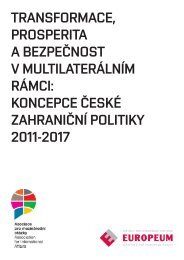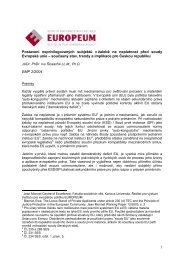eu constitutionalisation - EUROPEUM Institute for European Policy
eu constitutionalisation - EUROPEUM Institute for European Policy
eu constitutionalisation - EUROPEUM Institute for European Policy
Create successful ePaper yourself
Turn your PDF publications into a flip-book with our unique Google optimized e-Paper software.
Chapter 7: Flexible Integration in the Common Foreign and Security <strong>Policy</strong>During the Intergovernmental Conference a number of provisions containedin the Draft Constitution underwent fundamental discussions and substantialamendments. In order to follow this process in a chronological order particularattention has to be paid to the so-called “Naples-Document” dating 25November 2003³⁷ and the subsequent papers of 2 December, 5 Decemberand 9 December 2003.³⁸ Any additional document which refers to the legalframework of the CFSP do not alter the trade-offs consented be<strong>for</strong>ehand.³⁹These compromises reflected a high degree of mutual agreement among themember states. As expected, they have been incorporated into the constitutionaltreaty. The following analysis will be effected on the basis of thelegal framework offered by the final treaty text. Only in exceptional casesreferences will be made to the draft treaty or to respective documents issuedduring the IGC.A. Implementation of missions by a group of member statesThis <strong>for</strong>m of flexibility refers to the situation in which the Council, entrust theimplementation of a civilian or military task as <strong>for</strong>eseen in the Constitutionto a group of member states „which are willing and have the necessary capability<strong>for</strong> such a task“ (Article III-310 para 1 TCE). To this end the Council has toadopt a <strong>European</strong> decision by unanimity. According to Article III-210 para2 TCE the <strong>European</strong> decision has to contain detailed in<strong>for</strong>mation on theobjectives and scope and the general conditions <strong>for</strong> the implementationof the mission. The member states involved, in association with the UnionMinister <strong>for</strong> Foreign Affairs shall agree collectively on the concrete managementof the task. Despite of a considerable extent of autonomy conferredto the participating member states, they are obliged to regularly in<strong>for</strong>m theCouncil of the progress achieved during the operation either on their owninitiative or at the request of another member state. The mandatory liabilitytowards the Council is most visible in the event that the completion of thetask produces major consequences or requires amendments of the objective,scope and conditions. The Council is entitled to authorise necessary adaptationsto the legal basis of the operation by means of a <strong>European</strong> decision.37) See CIG 52/03 ADD 1 (Annex 17: CSDP).38) See CIG 57/03 (Defence); CIG 57/1/03 (Defence), CIG 60/03, ADD 1 (Annex 22: ESDP).39) See CIG 73/04 (Annex 24: ESDP); CIG 76/04 (Annex 20: ESDP), CIG 80/04 (Annex 4: CSFP), CIG 81/04 (Annex28, 29, 30 CFSP/CSDP).260Chapter 7: Flexible Integration in the Common Foreign and Security <strong>Policy</strong>One of the advantages attributable to this mechanism consists of the lackof any obligatory minimum number of participants <strong>for</strong> the benefit ofrapid coalition-building of the “able and the willing”. In other words, onlytwo member states would be sufficient to <strong>for</strong>m such a group in order toimplement a <strong>European</strong> mission. In return, all member states which do notcontribute to the group are bound to refrain from any opposing action.All other necessary decisions <strong>for</strong> the day-to-day business of the operationare exclusively decided by the participating countries. However, the constitutionaltreaty is not absolutely clear whether specific decisions, such as theOperation Plan (OPLAN) or the Rules of Engagement, generally taken in theframework of the Political and Security Committee (PSC), are <strong>for</strong>eseen <strong>for</strong>decision-making among the participating countries only, or if they are opento all EU members. Moreover, the treaty remains silent on the question ofparticipation rights <strong>for</strong> third countries willing to contribute to a <strong>European</strong>mission. In addition one may enquire about any alternatives, namely whether<strong>for</strong> the implementation of (extended) Petersberg tasks one may also resortto enhanced cooperation? The Constitution itself does not indicate anythingcontrary to this assumption since it does not establish a kind of hierarchicalorder between measures of enhance cooperation and the specific modes offlexibility. However, given the comprehensive catalogue of criteria whichhave to be met in order to launch enhanced cooperation, will reduce attractionof enhanced cooperation in this field will only.B. Permanent structured cooperationThe possibility to enter into a permanent structured cooperation as definedin Article I-41 para 6 TCE is open to those member states “whose militarycapabilities fulfil higher criteria and which have made more binding commitmentsto one another in this area with a view to the most demanding missions”.Both, the criteria and the necessary operational commitments to make arelisted in a separate protocol added to the constitutional treaty. This meansa significant improvement compared to the draft treaty issued by theConvention, which has left the definition of the criteria and the specificationof the commitments up to the member states. As a result of logisticshortcomings and ambiguous terms, such as “higher criteria”, but evenmore because of the common demand by the member states to establishstructured cooperation as an inclusive and predictable institution, has ledto revision of the relevant provisions during the IGC.261








